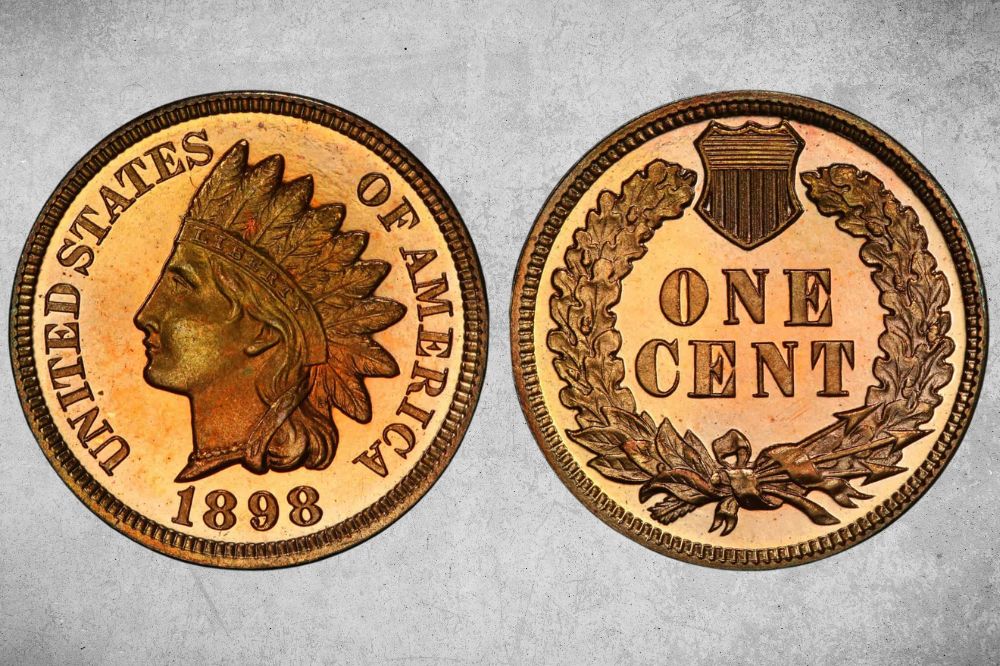The Indian Head penny is one of the most distinctive of all American coins. But is it valuable?
We’re going to look at a single year’s mintage to answer that question. We’ll explore the 1898 Indian Head penny value, its history, and varieties. And we’ll look at what separates an ordinary penny from something that will get collectors hot under the collar.
Ready to find out more? Step this way …
1898 Indian Head Penny Details
- Category: Indian Head pennies
- Mint: Philadelphia
- Total mintage: 49,823,079
- Designer: James Barton Longacre
- Edge: Plain
- Diameter: 19.0 millimeters
- Composition: 95% copper, 5% tin and zinc
- Weight: 3.11 grams
1898 Indian Head Penny Value Chart |
||||
| Mint Mark and Color | XF45 | MS60 | MS65 | MS67 |
| 1898 (P) No Mint Mark Indian Head Penny, Brown | $50 | $65 | $280 | $400+ |
| 1898 (P) No Mint Mark Indian Head Penny, Red and Brown | n/a | n/a | $385 | $2,350 |
| 1898 (P) No Mint Mark Indian Head Penny, Red | n/a | n/a | $800 | $8,000 |
| PR61 | PR63 | PR65 | PR67 | |
| 1898 (P) No Mint Mark Proof Indian Head Penny, Brown | $175 | $300 | $650 | $2,350 |
| 1898 (P) No Mint Mark Proof Indian Head Penny, Red and Brown | $190 | $325 | $675 | $5,200 |
| 1898 (P) No Mint Mark Proof Indian Head Penny, Red | n/a | $375 | $1,550 | $12,500 |
| 1898 (P) No Mint Mark Proof Indian Head Penny, Cameo | n/a | n/a | $1,600 | $25,000 |
| 1898 (P) No Mint Mark Proof Indian Head Penny, Deep Cameo | $200 | $625 | $6,250 | n/a |
1898 Indian Head Penny Values and Varieties Guides
1898 (P) No Mint Mark Indian Head Penny Value
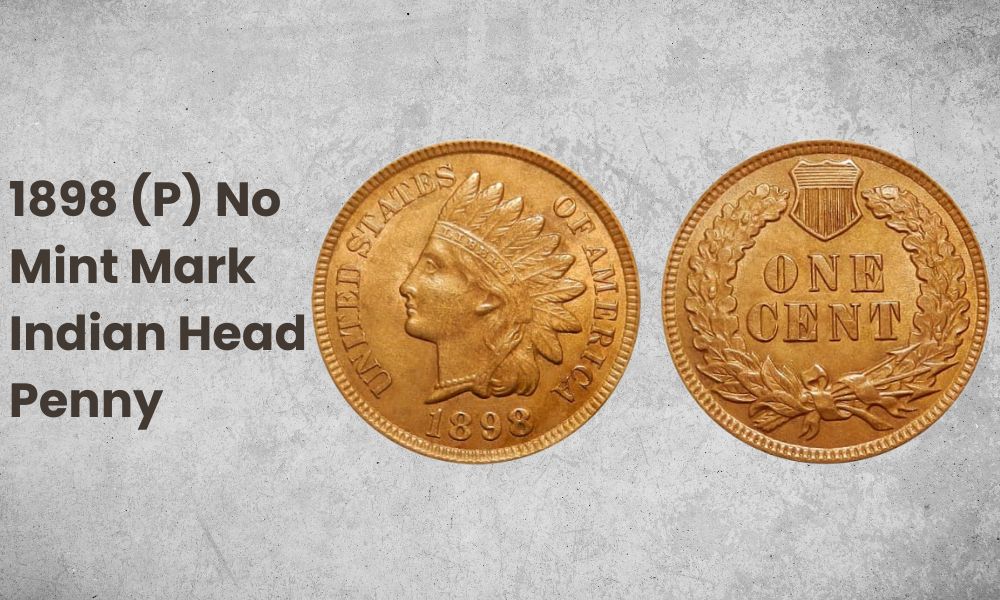
- Type: Indian Head pennies
- Edge: Plain
- Mint mark: None
- Place of minting: Philadelphia
- Year of minting: 1898
- Face value: $0.01
- $ price: $6 to $25,000
- Quantity produced: 49,821,284
- Designer: James Barton Longacre
None of the Indian Head pennies minted in 1898 carry a mint mark. That’s because they were all struck at the Mint facility in Philadelphia. That didn’t begin adding its own mint marks to coins until 1942.
The value of the 1898 Indian Head penny depends on its color and condition. All other things being equal, coins graded brown are the most affordable, while red coins are the most desirable. As you might expect, coins classified as “red and brown” fall somewhere in between.
Almost 50 million coins were struck for circulation in 1898. Today, it’s possible to pick one up for as little as $6. That will buy you a brown coin in poorer condition, graded 3 on the coin grading scale. (The scale goes from 1 to 70, the latter signifying a flawless coin.)
The more detail that remains on the coin, the better the condition and the more valuable it will be. Coins graded 60 to 70 on the grading scale are classed as uncirculated, or “mint state”. A brown coin graded MS60 is worth around $65. That increases to $100 at MS63.
Coins graded 65 and above are termed “gem quality”. A brown coin graded MS65 is valued by the independent coin graders the PCGS at $280. Move up a point to MS66, and a coin of the same color is $400.
Red and brown coins in uncirculated condition start at $80 for a coin graded MS62. And a gem quality MS65 red and brown penny is valued at $385. The finest known red and brown 1898 pennies are graded MS67 and valued at $2,350.
Red pennies are the cream of the crop. The PCGS sets values for these for grades from MS63 upwards. An MS63 example is worth about $185. And the finest red pennies known to exist are two coins graded MS67+. Those are valued at an impressive $25,000 apiece.
1898 (P) No Mint Mark Proof Indian Head Penny Value
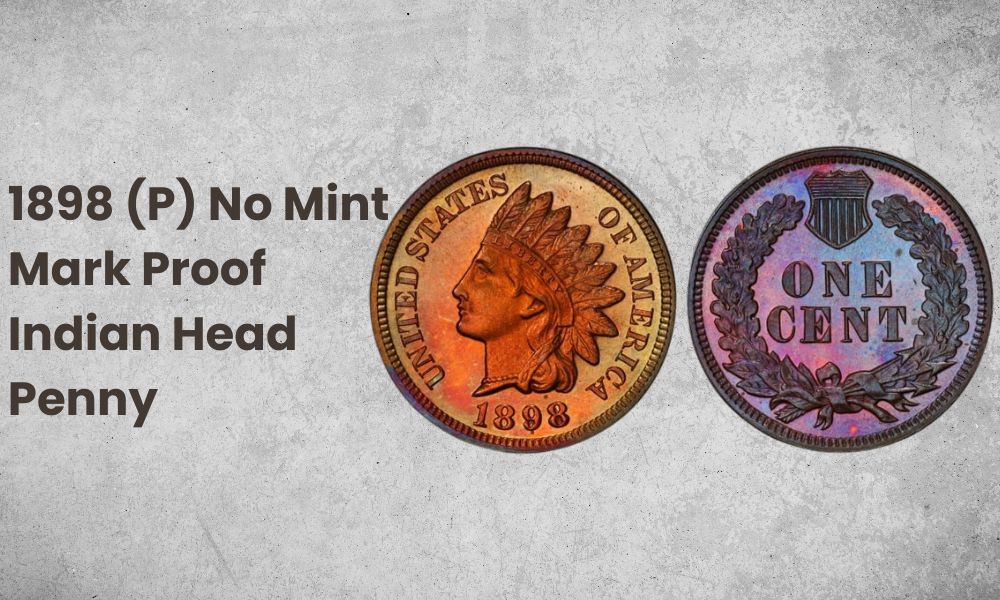
- Type: Indian Head pennies
- Edge: Plain
- Mint mark: None
- Place of minting: Philadelphia
- Year of minting: 1898
- Face value: $0.01
- $ price: $160 to $25,000
- Quantity produced: 1,795
- Designer: James Barton Longacre
In addition to the regular, or “business strike” pennies struck in Philadelphia in 1898, the Mint also struck 1,795 proof coins. These were made using specially prepared dies on carefully selected and polished planchets. They were intended for collectors and coin archives.
The small production run means that any proof coin is worth good money today. Like business strikes, proofs are graded by color – brown, red, and red and brown. And there are two further categories – cameo and deep cameo.
Cameo proofs are coins where there is an attractive contrast between reflective fields and frosted devices. (The fields are the flat areas of the coin, while the devices are the design elements.) Deep cameos are those where the contrast is particularly strong.
A brown 1898 proof penny graded PR61 is valued by the PCGS at $175. They don’t offer a value for brown coins graded PR60. But a red and brown coin at that level is valued at $160.
For red 1898 pennies, the lowest grading for which the PCGS offers a value is PR63. It prices a coin at that grade at $375. At the other end of the scale, the sole red penny to have been graded PR67+ is worth about $17,500.
All other things being equal, cameos and deep cameos are the most sought after of all proof pennies.
A cameo graded PR64 is valued at $1,350, while values move into five digits ($10,000) at MS66. The finest 1898 pennies with the cameo designation are graded PR67. Five such coins are known to exist, and the PCGS values them at $25,000 each.
Deep cameos are known to exist at grades from PR64 to PR66+, with values ranging from $1,450 to $11,500.
Also Read: Top 15 Most Valuable Indian Head Penny Worth Money
History of the 1898 Indian Head Penny
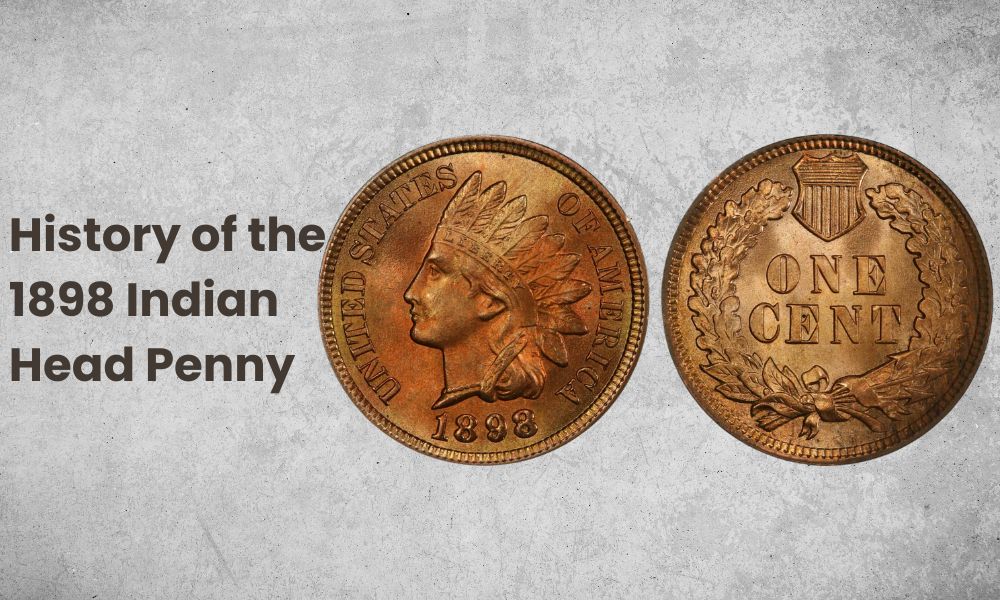
The penny struck in 1898 is known as the Indian Head penny after the image on the obverse. It shows what at first glance appears to be a Native American in a traditional feathered headdress. Look closer, however, and the legend on the headband identifies the figure as Lady Liberty.
It’s the work of an artist named James Barton Longacre. Longacre was the Mint’s Chief Engraver, and he designed the coins as a replacement for the Flying Eagle penny. The first Indian Head pennies were produced in 1859.
Like the Flying Eagle, they were smaller than the pennies of earlier eras. This was a result of rising copper prices increasing production costs. The Indian Head penny was the same diameter as today’s cents, 19 millimeters, but a little thicker.
The first Indian Head pennies were made of 88 per cent copper, with the rest nickel. In 1864, however, the recipe changed, with the copper content increasing to 95%. The remainder was a mixture of zinc and tin.
This is the same composition used for the 1898 pennies. As a result, those are lighter than their pre-1864 counterparts – 3.11 grams compared to 4.7 grams.
Details of the design changed too. Until 1860, the reverse of the penny had borne the image of a laurel wreath. But that year the design changed to a wreath made of oak leaves and surmounted by a shield. Small changes were also made to the shape of the cut-off of Liberty’s bust.
Until 1907, Philadelphia was the only Mint facility legally permitted to strike cents. That changed the following year, with the production of the first ever Indian Head pennies to bear the San Francisco mint mark.
The last Indian Head pennies were struck just a year later. They were replaced by the Lincoln penny, which is still being made today.
Also Read: Top 20 Most Valuable Old Pennies Worth Money (Penny Collection)
1898 Indian Head Penny Grading
Grading Indian Head pennies means looking at both their condition and their color.
A coin in perfect condition will get the maximum of 70 marks. One with so much wear it’s only just possible to identify the year and denomination will get the minimum of 1.
A coin that’s the red of new copper over at least 95 per cent of its surface area will be designated red. If the same proportion is the brown of copper that’s been handled and exposed to the air, it will be designated brown. Anything in between is classified red and brown.
This YouTube video from Couch Coin Clips shows how these principles apply to color grading another copper coin, the Wheat penny.
1898 Indian Head Penny Errors
1898 (P) No Mint Mark Indian Head Penny, Partial Collar
When planchets are struck with the die, they should be held in place by a collar. But sometimes the collar isn’t in quite the right position. When that happens, part of the edge of the coin will show evidence of contact with the collar.
That was the case for one 1898 Indian Head penny. That coin bore the imprint of the collar around the top of the obverse. It had been circulated and was graded XF45 – extremely fine. It sold at auction for just over $50.
1898 (P) No Mint Mark Indian Head Penny, Double Struck, Second Strike Off-Center
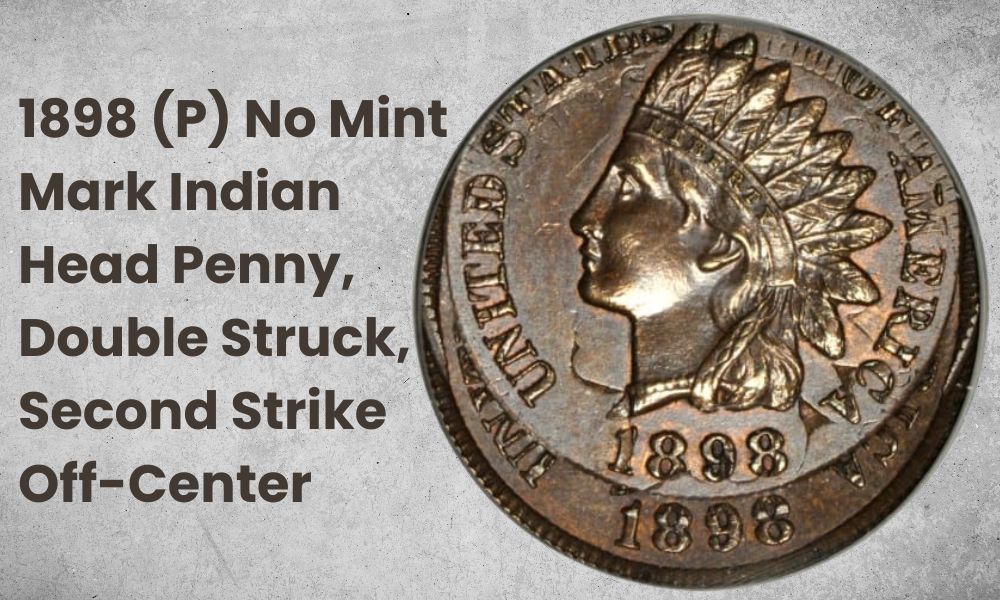
Very occasionally, a planchet that has already been struck isn’t ejected from the coining chamber. It’s then struck a second time.
That happened to an 1898 Indian Head penny. And to add another layer of interest, the second strike was positioned 95 per cent off-center. The result was a coin with a weird bulge at the 11 o’clock position when viewed from the obverse.
Although a brown coin, it was in very good condition, graded MS65. And when it was presented at auction, it sold for $1,400.
Another example of the same type of error had the second strike just 10% off-center. Though still an attractive coin, it wasn’t in such good condition either – graded AU55 (“about uncirculated”) by the PCGS. It sold at auction for $745.
1898 (P) No Mint Mark Indian Head Penny, Obverse Double Struck in Collar
Another 1898 Indian Head penny was double struck whilst held in place by the collar. The result was a distinctive double image, the doubling particularly evident on the cut-off of Liberty’s bust and the lower feathers of her headdress.
It was a brown coin and it was pretty worn, graded just G06 (“good”) by the PCGS. Nevertheless, the interesting error saw it fetch $160 at auction.
1898 (P) No Mint Mark Indian Head Penny, Struck Through Capped Die
Very occasionally a planchet attaches itself to the die after it’s been struck. The result is a “capped die”. And one 1898 Indian Head penny was struck by a die in this condition.
Whilst the reverse looked normal, the obverse had virtually no detail as a result. Almost all that could be made out on that side of the coin was the date.
It was graded MS66 brown by the NGC and sold at auction for $625.
1898 (P) No Mint Mark Indian Head Penny, Triple Struck and Rotated In Collar
Sometimes coins are struck not once or even twice, but three times. That happened to one 1898 Indian Head penny, that was also rotated in the collar.
The triple image was relatively subtle, and the coin was graded at only XF40 brown. It nevertheless made $575 at auction.
1898 (P) No Mint Mark Indian Head Penny, Multistruck, Two Dates
One 1898 Indian Head penny was struck multiple times, with the date appearing twice on the obverse. The unusual looking brown coin was graded AU58 – about uncirculated – by the PCGS. And it sold at auction for over $1,700.
This YouTube video from Couch Collectibles shows you examples of all these error coins and more.
FAQs
What is the rarest Indian Head penny?
The 1861 Indian Head penny was struck in lower numbers than any of the other copper-nickel cents (those produced from 1860 to 1864). Today, it’s the rarest of those dates in circulated condition.
In gem condition – coins graded MS65 and above – the rarest of the copper-nickel pennies is the 1864 mintage.
The lowest mintage of all was the 1909 Indian Head penny, the last in the series. Only 309,000 of those coins were produced.
Another key date is the 1877 Indian Head penny, with a mintage of 852,500. An example graded MS66 red by the PCGS sold at auction in 2009 for just shy of $150,000.
How much is an Indian Head penny worth?
The value of an Indian Head penny depends on its rarity, which in turn depends on its condition and whether it has an interesting error.
The least expensive Indian Head pennies are those from years with a high mintage, and in poor condition. Those can be picked up for less than $10.
At the other end of the scale, coins from rare mintages and in the finest condition can sell for six figure sums.
